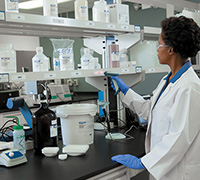Cancer Research Center Accelerates Research in the Face of Safety and Compliance Needs
Challenge
For one of the world’s most renowned cancer treatment and research centers, complying with changing hazardous materials regulations was becoming increasingly difficult. Updating spreadsheet reports annually was insufficient, while maintaining records in real time would impose too great a burden on scientists, taking away time from furthering their research instead. Time was a crucial resource for this institute, which needed to rapidly translate knowledge gained in the laboratory into clinical care, thereby converting discoveries into applications that could save lives.
This challenge was just the tip of the iceberg for questions now facing the treatment center, such as:
- Are the laboratory spreadsheets accurate? Are filings complete? Could the center pass an audit or would it be fined?
- How could the center evaluate the time and resources needed to accurately and efficiently produce, review, correct, merge, and translate date for each report?
- Is the relocation of labs being delayed while calculating permissible threshold quantity limits? How are chemical loads determined before relocating a lab?
- Is the environment safe? What is the liability of having unknown substances in close proximity to patients, workers, and visitors?
- If an incident occurred, could there be a delay in external emergency response while waiting for hazardous chemicals to be removed?
There were a lot of questions, but not many answers. How could this research center meet the ever-changing regulation requirements and manage improvements to ancillary processes?
Solution
An Avantor Services Business Process Consultant worked with the center’s research administration, materials management, and Environmental, Health, and Safety (EH&S) teams to understand current processes, requirements, and future goals. After analyzing the gathered information from these sources, the consultant designed a best-fit solution that could be integrated into the center’s existing workflow or otherwise outsourced.

Result
A highly effective program was outsourced through a competitive bid process. Following implementation, the program:
- Returned nearly 3,000 hours per year to scientific research
- Documented accurate inventory of legacy hazardous materials, avoiding the loss of over 7,500 hours of research time
- Made real-time, electronic, accessible hazardous material information and data available instantaneously for regulatory reporting, inventory control, space planning, safety, and emergency communication. Previously, this information took weeks to obtain.
Annual Hours Spent Managing Hazardous Materials Data
Avantor Services implemented a system that reduced time spent managing hazardous materials data from 2,960 hours per year to zero hours per year.
